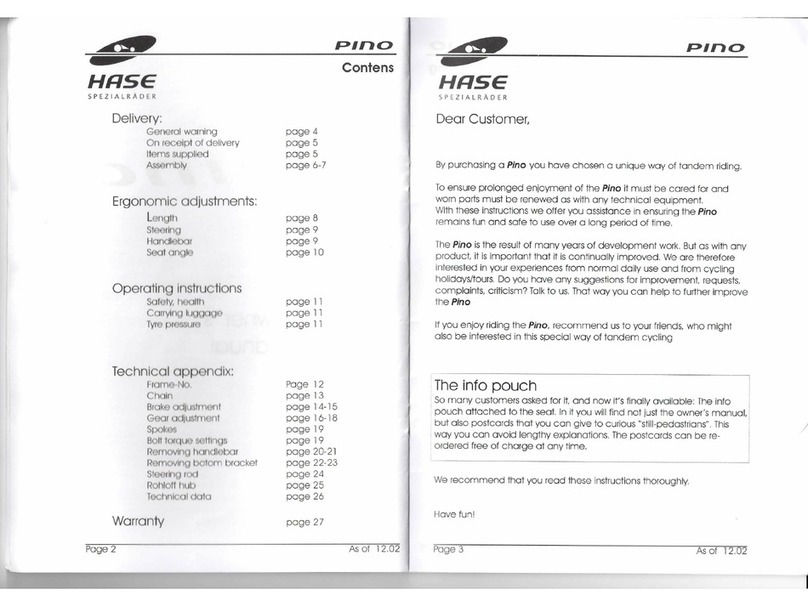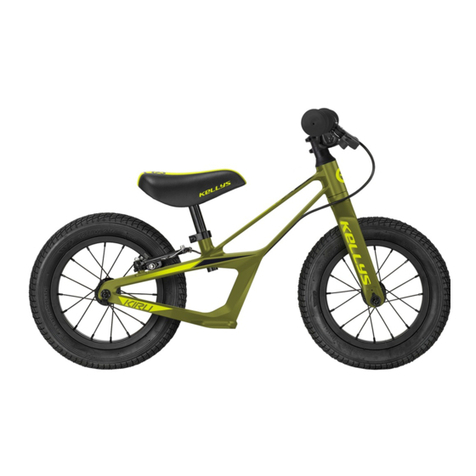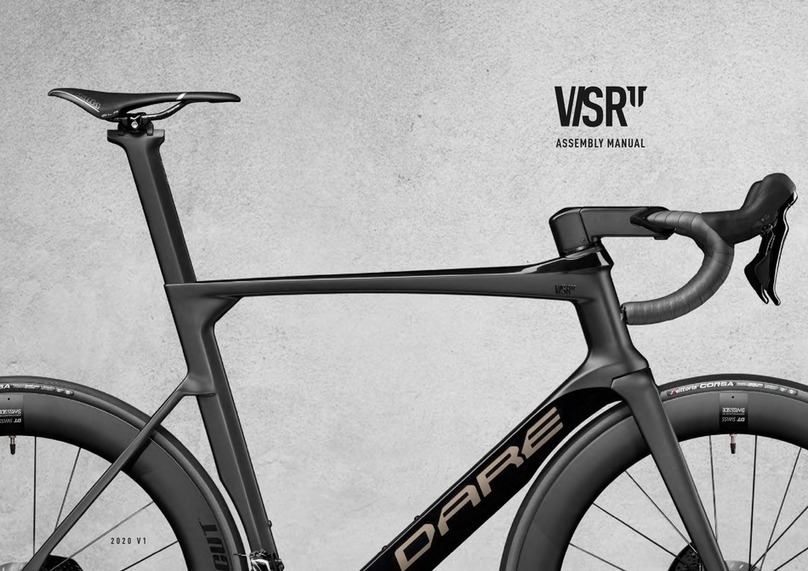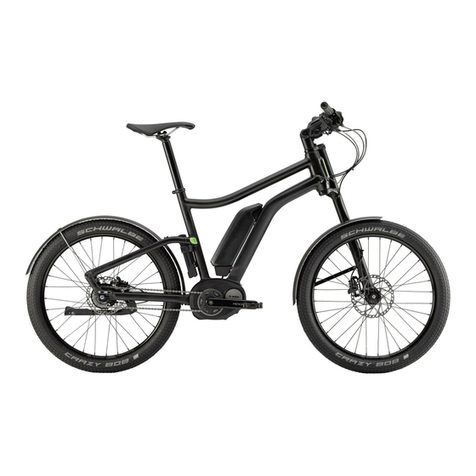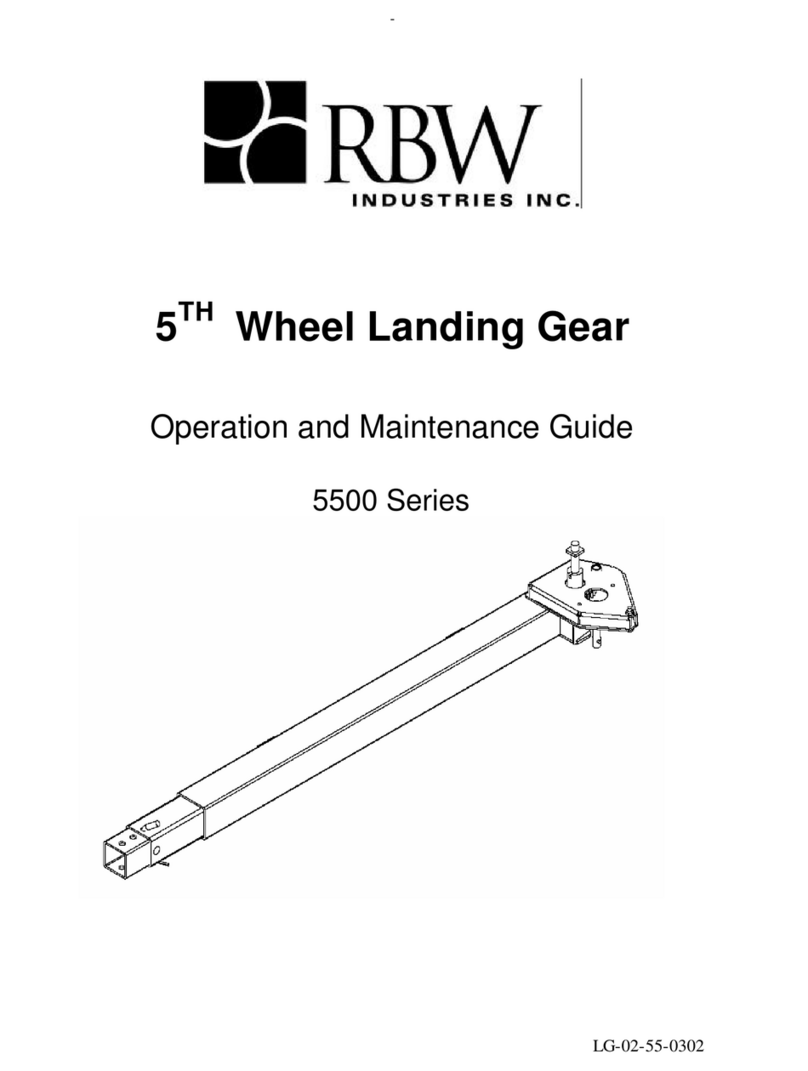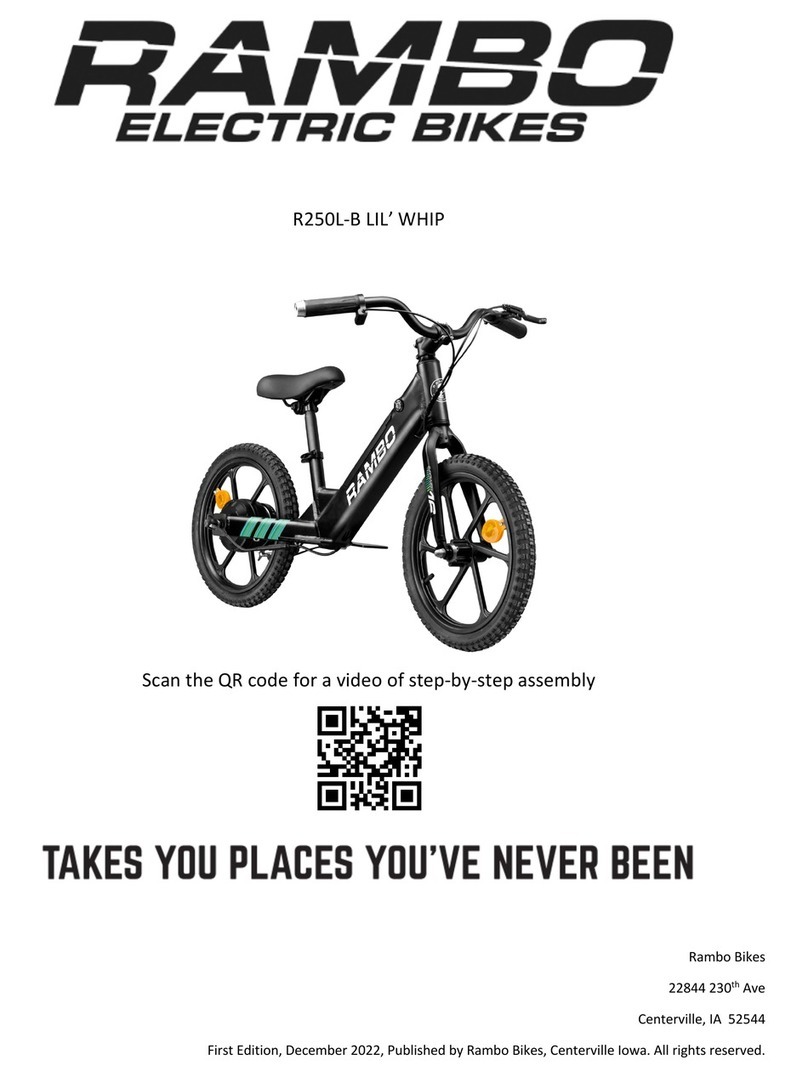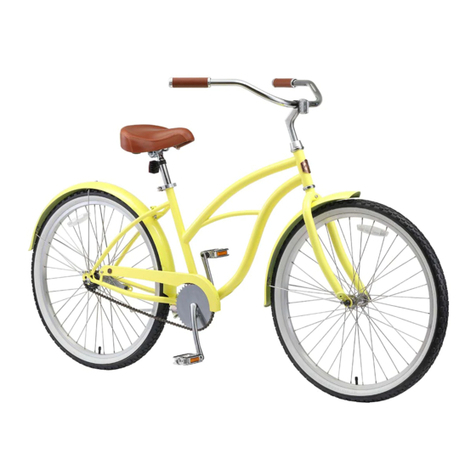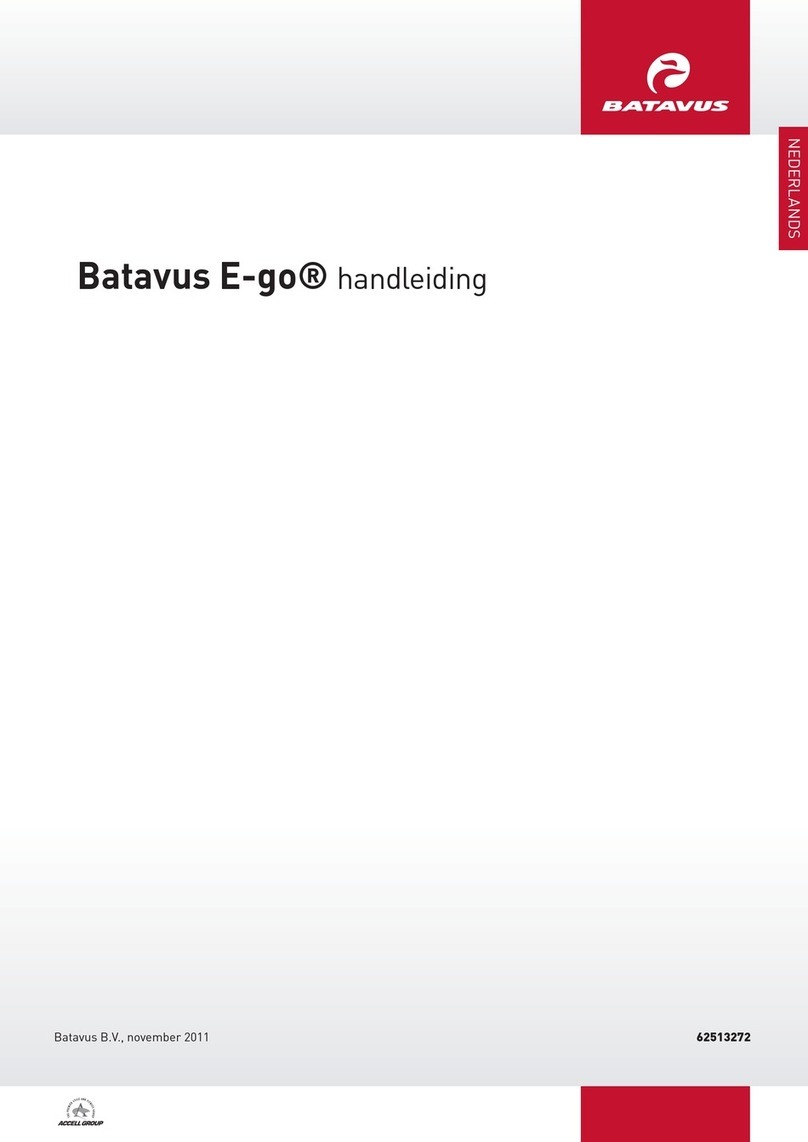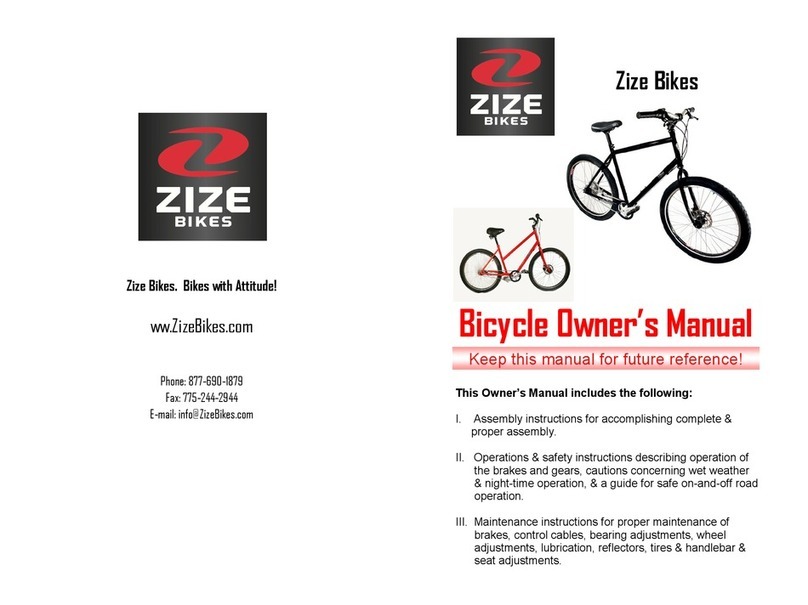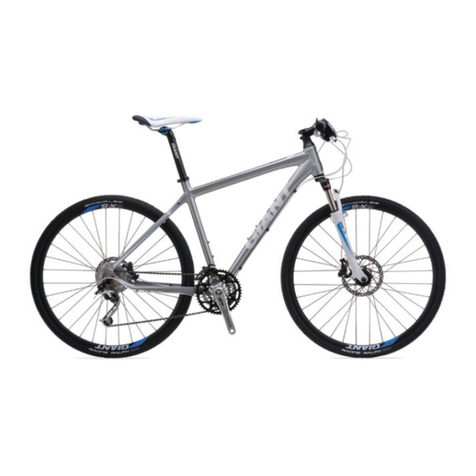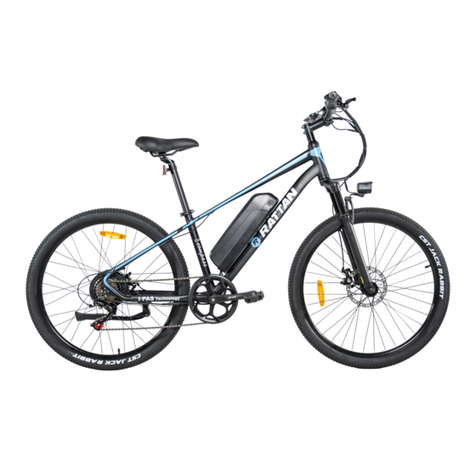Hase Spezialräder Pino User manual

P
INO
Owner`s
manual

Contens
S P E Z I A L R Ä D E R
H
A
SE
PINO
Page 2 As of 12.02
Delivery:
General warning page 4
On receipt of delivery page 5
Items supplied page 5
Assembly page 6-7
Ergonomic adjustments:
Length page 8
Steering page 9
Handlebar page 9
Seat angle page 10
Operating instructions
Safety, health page 11
Carrying luggage page 11
Tyre pressure page 11
Technical appendix:
Frame-No. Page 12
Chain page 13
Brake adjustment page 14-15
Gear adjustment page 16-18
Spokes page 19
Bolt torque settings page 19
Removing handlebar page 20-21
Removing botom bracket page 22-23
Steering rod page 24
Rohloff hub page 25
Technical data page 26
Warranty page 27

S P E Z I A L R Ä D E R
H
A
SE
PINO
Page 3 As of 12.02
Dear Customer,
By purchasing a Pino you have chosen a unique way of tandem riding.
To ensure prolonged enjoyment of the Pino it must be cared for and
worn parts must be renewed as with any technical equipment.
With these instructions we offer you assistance in ensuring the Pino
remains fun and safe to use over a long period of time.
The Pino is the result of many years of development work. But as with any
product, it is important that it is continually improved. We are therefore
interested in your experiences from normal daily use and from cycling
holidays/tours. Do you have any suggestions for improvement, requests,
complaints, criticism? Talk to us. That way you can help to further improve
the Pino
If you enjoy riding the Pino,recommend us to your friends, who might
also be interested in this special way of tandem cycling
The info pouch
So many customers asked for it, and now it’s finally available: The info
pouch attached to the seat. In it you will find not just the owner’s manual,
but also postcards that you can give to curious “still-pedastrians”. This
way you can avoid lengthy explanations. The postcards can be re-
ordered free of charge at any time.
We recommend that you read these instructions thoroughly.
Have fun!

General warning
S P E Z I A L R Ä D E R
H
A
SE
PINO
Page 4 As of 12.02
Like any sport, bicycling involves risk of injury and damage.
By choosing to ride a bicycle, you assume the responsibility
for that risk, so you need to know - and to practise - the
rules of safe and responsible riding and of propper use
and maintenance. Proper use and maintenance of your
bike reduces risk of injury.
!Riding a tandem needs time to get used to. Both captain and
stoker have to work together. Aspecialy leaning into corners
needs a bit of comunication between captain and stoker. We
recommend to make the first runns off the trafic. Ones you feel
comfortable, you can start riding in the trafic.
!The Pino comes with very poverfull brakes with excelent
modulation. Besides having excelent modulation, it is still
possible to blokade both wheels. Make yourself comfortable
with the brake setting, befor riding in traffic.
!For your own savety: Allways wear an approved helmet when
riding your bike and follow the helmet manufacturer’s instruction
for fit, use and care of your helmet.
!On the Pino the rider should wear clothing that is close-fitting
enough to make it impossible for garments to get caught in the
wheel or the drive. Watch out also for hanging string/tying cords
for example from jackets or a scarf.
!Due to the recumbent position, the stoker might slip from the
pedal. Aspecaly when the captain stops pedalling sudden.
Make sure that the stoker has enough hold on the pedal. We
recommend to use spd-style Pedals or our Special-pedals with
hooks and straps.
!Allways cycle with lights from dusk til dawn.
!The Pino must be checked by a professional workshop
frequently.

On reciept of delivery
S P E Z I A L R Ä D E R
H
A
SE
PINO
Page 5 As of 12.02
If your Pino is sent by post, the following must be observed.
On receipt of delivery...
please check the packaging for damage. If you discover anything, have
the delivery person confirm it to you in writing. Damage can occur
anywhere on the journey from Waltrop Germany to the recipient. The
parcel service is liable in case of damage.
Items supplied:
For better handling during shipping, we took a few parts off the Pino and
split it in two boxes.
Please check the contents of both boxes.
In the big box you should find the Pino with dismounted stem and
handlebar.
In the small box you should find:
!Owner’s manual (you’ve found it already)
!Brake manufacturer’s instructions
!Two pairs of pedals
!Five Hase-straps
!Two Aluminium tubes for the seat
!Seat mesh for seat and back
!Two seat-grips
!Info bag

Assembly
S P E Z I A L R Ä D E R
H
A
SE
PINO
Page 6 As of 12.02
Insert frontboom
At first connect both light-cables then insert the frontboom without
twisting the chain. To prevent damaging the slide-bearing-paper,
disassembly the QR and insert the frontboom from a slightly down angle.
Slide the frontboom into the mainframe, until the mark for maximum
length disappears. Than put on the chain like shown on page 7.
Plug Quick release
Slide bearing foil
Mark for maximum length
Handlebar
Take all screws out of the headset. Then
slide the handlebar on the steerer tube
head like shown on the picture, insert the
four screws and tighten them.
More information about adjusting on
page 8.
Front Rear
Steerer tube
head

Assembly
S P E Z I A L R Ä D E R
H
A
SE
PINO
Page 7 As of 12.02
Put on the seat
Slide one side of the seat on the
seat mount of the frame, then pull
the opposite seat tube away from
the frame until you can slide it on
the seat mount.
Now stretch the seat mesh over
the two front tubes of the seat and
use the Hase-straps for tighten it
underneath.
Once the seat mesh is mounted,
you can insert the seat-grips until
the end and tighten the screws
with a 5mm allenkey.
Skrew
Lay the rear seat mesh around the back
of the seat and insert the two aluminium
tubes into the seat mesh. After stretching
the seat mesh they should not touch any
seat tube.
For stretching, run the three Hases-straps
trough the slot of the mesh, around the
aluminium-tubes on both sides and
tighten them.
Fit the info pouch with the velcro straps
between the middle and lower Hase-
strap.

Length
S P E Z I A L R Ä D E R
H
A
SE
PINO
Page 8 As of 12.02
Quick release
For length adjustment open the adjusting screw at the chain tensioner.
Open the quick release, find a comfortable rider position and close the
quick release again. Now turn the chain tensioner clockwise until the
chain is under tension. and tighten the adjusting screw (5mm allen key).
Due to its wide range of adjustment it might be necessary to work on the
chain-length.
Note:
Locking and unlocking the quick release levers is always done either by
levering up or down respectively.
To adjust the locking force, screw the nut at the opposite in or out.
S P E Z I A L R Ä D E R
H
A
SE
Adjusting screw chain tensioner
Caution:
Don’t extend the frame to far. At maximum length, the mark (grain size
in the front boom) must be hidden in the mainframe.

Steering
Handlebar
S P E Z I A L R Ä D E R
H
A
SE
PINO
Page 9 As of 12.02
At the captains position at the rear, you can adjust the handlebar in
width, height , length and angle.
To adjust the width or height of the stainless steel handlebar grips, open
screw A and B. Now you can twist the handlebarends to the right length.
To adjust the height, just pull the handlebarends out to a suitable
position. The handlebarends must be insert over the whole black clamp
length, don't exceed this.
The handlebar angle and length can be adjusted to a sporty or relaxed
position. Open all 4 C screws and push the handlebar forward to a
sporty long position or backwards to a short upright and relaxed position.
Once a position is found, tighten all 4 screws firmly.
To adjust the seatgrips for the stoker in front, open screw D and force it
with a plastic hammer into the seat. Now you can turn the grip into a
upright position for short or down for tall people. In the upright position it
also stables the body of the stoker. The grips must be inserted in the seat
S P E Z I A L R Ä D E R
H
A
SE
Screw A und B
Srew C (x4)
Screw D

Seat angel
S P E Z I A L R Ä D E R
H
A
SE
PINO
10Page As of 12.02
For adjusting the seat angle, open the quick release and move the seat
up or down.. Once you found a comfortable angle, close the quick
release firmly.
Caution:
The upper seat mount is the main point that holds the seat. Make sure
that the quick release is closed firmly.
S P E Z I A L R Ä D E R
H
A
SE
Quick release

Safety, health
Carrying luggage
Tyre pressure
S P E Z I A L R Ä D E R
H
A
SE
PINO
Page 11 As of 12.02
Helmet:
We recommend that you wear a helmet for your own safety when
travelling on any cycle.
Clothing:
On the Pino, the rider should wear clothing that is close-fitting enough to
make it impossible for garments to get caught in the wheel or the drive.
Watch out also for hanging string/tying cords for example from jackets
or a scarf.
Health:
When you ride the Pino, different muscle groups are used compared to
riding a standard bicycle. Take into account, therefore, that you will
need a short period of time to adjust.
You should avoid cycling too hard. A higher pedalling frequency (above
70 rpm) is better for your joints.
Cycling at night:
Always cycle with lights from dusk til dawn.
Carrying luggage:
If you ‘re planning a long journey with the Pino and intend taking a lot of
luggage, we recomend the use of a Hase lowrider luggage rack in
addition to the rear bike rack.
Tyre pressure:
Check tyre pressure, every time you start your ride. We recommend to
use the maximum tyre pressure, written on the sidewall of the tyre.

Frame number
S P E Z I A L R Ä D E R
H
A
SE
PINO
Page 12 As of 12.02
The frame number of your Pino is stamped into the left rear dropout..
Make a note of the frame number and kep it somewhere safe.
S P E Z I A L R Ä D E R
H
A
SE
Frame number

Chain
S P E Z I A L R Ä D E R
H
A
SE
PINO
Page 13 As of 12.02
Renewing the chain:
The Pino has a relatively long chain, which means it has a longer service
life. Thus the chain need not be renewed so often compared with normal
bicycles.
Like on every tandem, the rearchain wears out a lot faster then the front
one.
The most accurate way of checking the chain is with the use of a wear
indicator gauge, available from bicycle shops.
When joining the link of a chain, it is essential to check that the chain has
not become twisted in the chain protector tube.
The chain length for the maximum frame length of the Pino is approx.
3620mm in front. The rear chain has a lenght of approx. 1340mm .
Chain protector tube:
The clamp of the chain protector tube must be bolted to the retainer
plate so the tube can follow the line of the chain without rattling. A lock
nut is fitted in the workshop to prevent the bolt from becoming loose.

For adjusting, service and all works on the brake, read the
brake manufacture’s instructions - “Magura Workshop 2002”
or “Magura Workshop 2003”.
To get the full warrenty, you need to send the included
warrenty-card to Magura.
The brake information in this manual is only additional. They don’t cover
all the informations you need.
Brake adjustment
S P E Z I A L R Ä D E R
H
A
SE
PINO
Page 14 As of 12.02
Reach adjustment:
To accomodate the brakelever to the size of your hand use the small
screw in the grip (2mm allankey). Turn clockwise for large, anti clockwise
for smaller hands.
Adjusting skrew

Brake adjustment
S P E Z I A L R Ä D E R
H
A
SE
PINO
Page 15 As of 12.02
S P E Z I A L R Ä D E R
H
A
SE
Whats special on Magura’s Julie andem version:
On your Pino you find the tandem version of Magura’s Julie. It is an extra
powerful version with some special features. For servicing or working on
the brake, keep some points in mind:
!Allways use the original Magura steelflex tubes only.
!Allways use original Magura discbrake-rotors with 180mm
diameter only.
Braking noise:
New brakes or new brake pads need time to wear in. This might result in
a quiet slithering sound in the beginning. It will stop after the brake pads
get their position.
Intermediate noise might also be a result of a not proper fitting wheel.
Make sure that the wheel sits completely in the dropouts and that the
Quick release is closed firmly.
If the sound doesn’t stop after a while or if it becomes noisy, check
again if the disc brake-rotor is still running true. Damaged rotors must be
changed. Control the position of the rotor under the disc brake-caliper.
The disc should run straight under the joint, where both sides of the
caliper are coming together. If not, work like shown in the brake
manufacturer’s instruction or go to your bike-dealer.
Take off the wheels:
Don’t pull the brakes when the wheels are off. If it happens, watch the
brake manufacturer’s information. For transport without wheels use a
spacer between the brake pads.

Gear adjustment
S P E Z I A L R Ä D E R
H
A
SE
PINO
Page 16 As of 12.02
Adjusting lowest gear
-Select 9th gear on the right-hand shifter. The chain
should be on the smallest sprocket.
-Turn the crank via the pedal. If the chain already
makes a noise on the second sprocket or shifts onto
it, screw in adjusting screw 1 clockwise until the noise
stops or the chain shifts back onto the smallest
sprocket.
-Select 8th gear on the grip shifter while turning the
crank in direction of drive via the pedal.
Turn the crank in direction of drive via the pedal and
select all gears one after the other, going up the
range and back down. Adjust if necessary.
-Slowly guide the derailleur by hand back under the
smallest sprocket.
-The derailleur features an adjusting screw with which
the clearance between the jockey wheel and the
sprockets can be adjusted.
Adjustment with chain fitted and upper jockey wheel
under largest sprocket - adjust the clearance so that
when the crank is turned backwards, it is just possible
for the chain to drive without making any noise.
Pre-adjustment of derailleur
(This can be carried out easiest with the chain
removed)
-Guide the upper jockey wheel under the smallest
sprocket (and hold in place). Turn adjusting screw H
in or out until the jockey wheel is centred under the
smallest sprocket.
-Guide the upper jockey wheel under the largest sprocket (and hold in place).
Turn adjusting screw L in or out until the jockey wheel is centred under the largest
sprocket.
-If the chain does not shift, turn adjusting screw 1 clockwise, i.e. adjust the cable
until the chain shifts onto the second sprocket.

Gear adjustment
S P E Z I A L R Ä D E R
H
A
SE
PINO
Page 17 As of 12.02
Trouble shooting
Problem Cause Remedy
CHANGING GEAR
Chain slips o ff smal lest
sprocket onto frame.
-Adjusting screw H is
screwed out too much.
Turn screw H clockwise
(diagram 17) until upper
jockey wheel is flush with
smallest sprocket.
Chain shi fts onto smal lest
sprocket with difficulty or
not at all.
-Adjusting screw H is
screwed in too much.
-Cabletoo tight.
-Cable not operatin g
correctly.
-Turn screw H (diagram 17)
ant-clockwise until upper
jockey wheel is flush with
smallest sprocket.
-Turn a djusting screw 1
(diagram 21) clockwise (or
on right -hand gri p shifter )
until chai n shifts do wn with
ease.
-Check cableand lubricate
if necessary.
Chain slips off largest
sprocket in betwee n spokes
and sprock et, or chain
guide scrapes on spokes.
-Adjusting screw H is
screwed out too much.
-Derailleur or chain stay
end defor med.
-Turn scr ew L clock wise
until upp er jock ey wheel is
flush with largest sprocket.
-Align or renew.
Chain shi fts up with
difficult y but shifts down
with ea se.
-Cabletoo loose. -Turn a djusting screw 1
(diagram 21) anti-clockwise
(or on right -hand gri p
shifter) untilchain shifts up
with ea se.
Chain shi fts down wit h
difficult y but shifts up with
ease.
-Cabletoo tight.
-Cable not operatin g
correctly.
-Turn a djusting screw 1
(diagram 21) clockwise (or
on right -hand gri p shifter )
until chai n shifts do wn with
ease.
-Check cableand lubricate
if necessary.
Service and care:
Gear change: Lubrica te cable an d deraill eur occasi onally. C lean and li ghtly lubr icate
chain and jockeywheels on derailleur as and when necessary.
Do not use a high-pressure cleaner as the grease will be forced out of the bearings by the
force o f the j et.
In case the trike is to be placed outof service for some time, select 9th gear on the grip
shifter to relieve spr ing pres sure.

Gear adjustment
S P E Z I A L R Ä D E R
H
A
SE
PINO
Page 18 As of 12.02
Chainring
Outer chain guide plate
Innner chain guide plate
Adjustings krew L
Adjustings krew H
!
!
Low adjustment. Change the left and the right shifter to the first gear.
Then use adjustingskrew L to set the clearens between inner chain
guide plate and the chain to 0,5-1mm.
Cabeladjustment. For adjusting the index, change both shifters to
the first gear. The cabel should be just under tension. If it is to loose,
turn the adjusting nut at the shifter. Turn the adjusting nut, where the
cabel runns through, until the cabel is just under tension. Now turn
the cranks and chang to the second gear. The chain should runn
smooth to the middle chainring. Ones on the middlechainring it
should run without tuching the derailleur.
Caution: Avoid cross gears, don’t ride extreme gears like first and
Adjusting the front
derailleur:
If you need to adjust the front
derailleur work like followed:
!When carrying out adjustment, set
the chain to the largest chainring.
The outer chainguide plate must
be 1-3mm over the chain. Make
shure, that the outer plate, runns
parallel to the chainring. If not
loosen the derailleur-clamp and
push the derailleur into the right
position.
!Topadjustment. The shifter is still in
the third gear and the right shifter
in the 9th gear. Use adjustingskrew
H to set the clearens between the

Spokes
Bolt torque settings
S P E Z I A L R Ä D E R
H
A
SE
PINO
Page 19 As of 12.02
Spokes:
If spokes become loose or one of the wheels does not run true, the
wheel must be aligned.
If at any time the wheel is to be aligned in situ (frame or fork), it is
recommended that an alignment guide be used.
This could be, for example, an old spoke clamped to the frame or fork
and bent to the rim. This way any deformation of the wheel can be pin-
pointed.
If you aligne the wheel in a work stand, keep in mind that the wheel has
to be aligned 2,5mm to the left (discbrake). The Pino is build asymmetric
to get the same spoke angle on both sides. This will result in a stronger
wheel.
Bolt torque settings
The torque settings are determined according to specifications (Dubbel).
A torque wrench should be used when tightening.
Bolt quality 8.8
M5 5.5 Nm
M6 9 Nm
M8 23 Nm
If replace, only use bolt quality 8.8 or higher.
Before commencing any journey, check the bolts for tightness.

!Remove handlebar screw 1 and 2.
!Remove lock nut.
!Remove excenter clamp screw and pull the excenter off
the steerer tube.
!Unscrew the headset adjusting nut.
!Pull the steerer tube out of the frame.
!Now you can change the headset with its bearing races.
!For assembling follow these steps vice versa. Remember
to adjust the headset with the adjusting nut, then insert
the excenter, the lock nut and tighten the excenter
headlock at last.
The excenter clamp screw has to be tightened with
the required torque for M6 screws (9Nm). These
screw must be fitted with locktide. If these screw
comes of, steering will fail.
Removing handlebar
S P E Z I A L R Ä D E R
H
A
SE
PINO
Page 20 As of 12.02
Removing handlebar, change headset
Handelbar skrew1
Handlebar skrew2
Headset
adjusting nut
Excenter for
steering rod
Lock nut
Excenter
clamp screw
Other manuals for Pino
2
Table of contents
Other Hase Spezialräder Bicycle manuals
